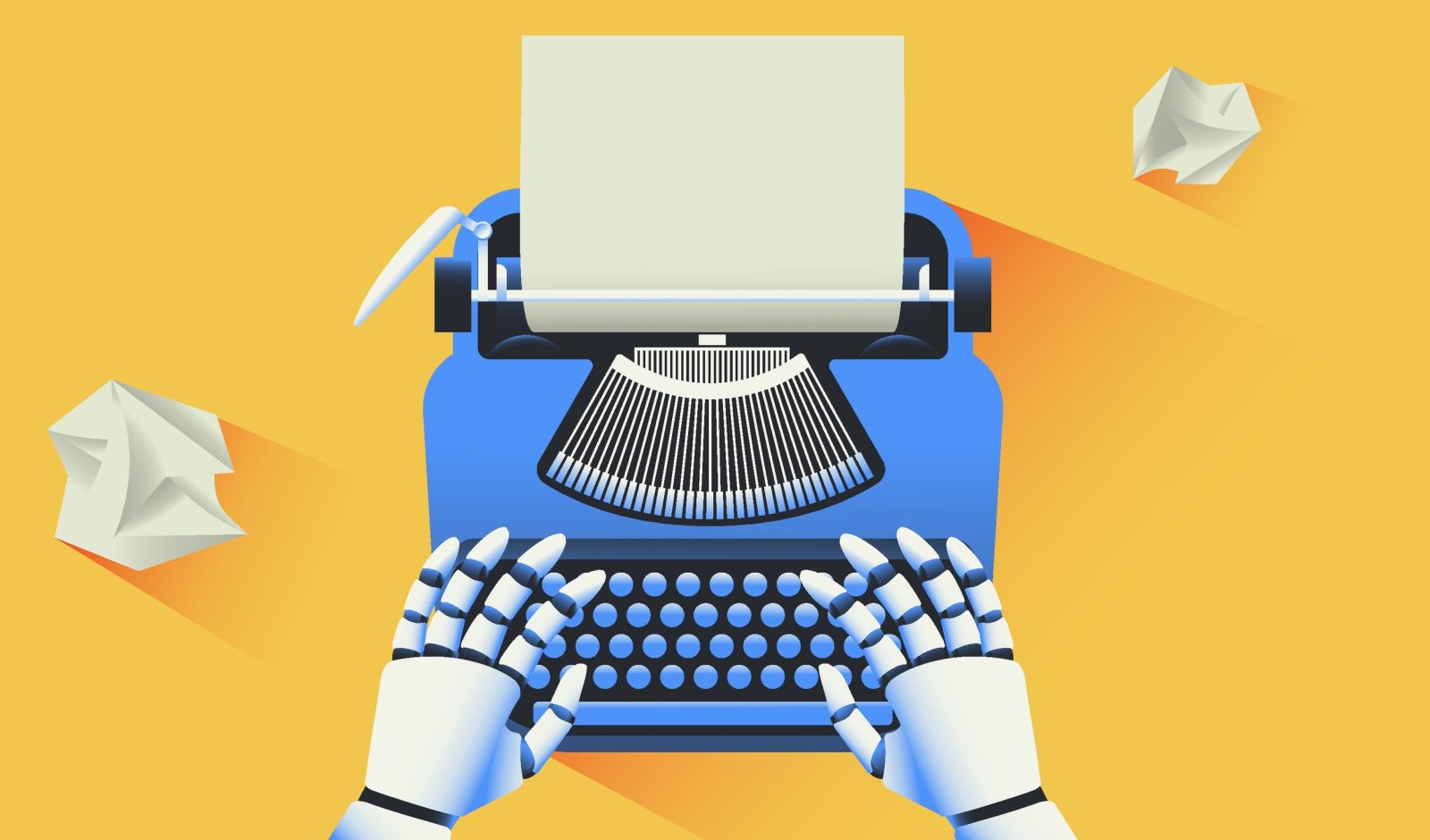The pivotal question all curious individuals must be asking today is what the future of literature is in the face of AI.
By Chimezie Chika
I
AI, Artificial Intelligence. Those are among the most frequently repeated words in the past couple of years. And it’s easy to see why. The world is witnessing a rapid metamorphosis of technology—a transition from human-assisted processes to increased automation. Granted that full automation is still a long way away, many are nevertheless already asking existential questions about the future of humanity and the crucibles of the system it has created over millennia.
And within those questions, inquiries about literary autonomy in the face of AI are emerging ever more frequently. These questions have not stopped the rapid adoption of AI—to small or enormous degrees—across artistic and literary spheres. And who’s to say they will not be more dominant in the future? A grim but logical conclusion is that a competitive race is afoot everywhere in the literary firmament. The notion that real creativity, the organic creation that emanates from pure human experience, is under great threat has rightly become one of the most contentious issues for literary scholars today.
While the argument among writers is how to make literature in the AI Age, the big concern for literary scholars—who are the scientists of literature, more or less—is how to confront the tech-mediated literary production of the age. There are many ethical questions to grapple with here, including who is creating the literature, the quality of what is created, and the integrity of the creation.
The point of such interrogations comes from noting that literature as we know it seems to be changing gradually as more and more tech resources and innovations get incorporated into it. The question I am asking is: what is the best way to critique literature in the era of AI?

In asking this question, I am not at all legitimising AI-produced work, I am instead trying to come to terms with the problems and possible advantages that our tech-savvy times poses for a writer, both as a subject matter and as a physical reality.
The learned exercise of literary criticism, formalised from the time of Aristotle’s Poetics (335 BCE)—the earliest extant theoretical text focusing on literature—has been complementary to the enterprise of creative writing and literary production. Aristotle’s approach in Poetics was to take the evidence of art, as it was performed in his time, at its observable value. His pioneering definition of literature—which he called “the poetic art”—was that, whatever form it takes, it is essentially mimetic. The mimetic imperative of literary art as an imitation or a reproduction of life has been foundational to literary criticism.
It must be noted that Aristotle most likely wrote on papyrus. This means that he was not widely read beyond the elites of classical Greece and Rome. And for a long time, well into the segregated societies of the Middle Ages in Europe, critical and exegetical readings of established texts, mostly of religious origins such as the Bible, was a cloistered affair confined to monks and educated elites attached to royal courts and families.
The arrival of the printing technology in the middle of the last millennia changed forever how literature and criticism is disseminated. As scholarship has shown, the sudden affordability of books caused not only the literary industry to boom, it also brought about the creation of new genres such as the novel, and the rethinking of criticism of literature through more than one periscope.
The predominant critical views of literature at this time moved from favouring classical ideas of unity and harmony of form and content, as defined in classical text, to the insistence of Baroque intellectuals on aesthetics as the true marker of a harmonious literary work. Ideas of “conceit” and “wonder” prevailed (this is certainly not too far from Aristotelian dramatic theory, but is majorly influenced by Longinus and, possibly, classics from ancient India and China).
The biggest shift in criticism happened during the Enlightenment age. The age was defined by an increased search for and valuation of knowledge as the ultimate arbiter of society and the individual. The major event of the enlightenment was the rise of public literacy, which in turn brought criticism into the mainstream.
Writing at the time, Samuel Johnson, who remains an influential figure of literary criticism even today, brought fearsome erudition and intellectual rigour to texts such as those of Shakespeare as well as the creation of a pioneering dictionary of the English language. The basis of much of the criticism was the hermeneutics of style, clarity, authorial background.
The subsequent critical engagement that emerged in the literature of the industrial age, that began in the late 18th century through the 19th, saw critics focus on instances of wider awareness in the text as well as qualities such as wit, knowledge, ethical and rhetorical qualities, though much of these were prescriptive.
This becomes evident in what the preeminent critic of the 19th century, Matthew Arnold, wrote regarding contemporary translations of Homer in his lectures, On Translating Homer: “that he is eminently rapid; that he is eminently plain and direct both in the evolution of his thought and in the expression of it, that is, both in his syntax and in his words; that he is eminently plain and direct in the substance of his thought, that is, in his matter and ideas; and, finally, that he is eminently noble”.
Here, he is giving guidelines on what he considers the principles of translating, without which a translator would have failed.
Thus, the last hundred or so years has given us many stimulating approaches to criticism. The dominance of a contextualised historical approach to criticism was rejected by the advent of formalist criticism, led by the American scholar, I.A Richards, the tenets of which were outlined in his seminal work, Practical Criticism.
Richard’s favouring of close reading of texts while eschewing authorial intention influenced a generation of western critics, especially in poetry. It could be said to be a response to the first World War and the novelties of destruction and political changes it brought.
But there are other movements that responded to historical moments. As the machinery of modernist art and literature moved, critical approaches to their many idiosyncrasies were offered. There were the Archetypal critics led by Northrop Frye, New Historicism, Psychoanalytical criticism led by the likes of Sigmund Freud and Carl Jung, and of course, after the age of colonialism dissipated in the mid to late 20th century, postcolonial criticism became an outlet for intellectuals from formerly colonised countries.
Some seminal works here—Edward Said’s Orientalism and Gayatri Chakravorty Spivak’s essay, “Can the Subaltern Speak?”—has theorised the relationship between colonial conditioning and the response of the postcolony.
Further theories that sprung out of modernist disillusionment are structuralism, poststructuralism, postmodernism—all of which form angles from which critics examined a series of peculiarly structured works that emerged in the decades that followed. There is often a tendency here to embrace hybridity as the world advances rapidly in scientific and sociological terms. Often, a merger between philosophical, linguistic, and political ideologies are deliberately projected.
Much of what we have today revolves around the principles of practical criticism, political ideology, and revolutionary reappraisals from the point of view of gender and sexuality which began back in the 1960s.
II
The pivotal question all curious individuals must be asking today is what the future of literature is in the face of AI. The background of criticism brings us to that curious dilemma. In an age where social media, AI, and as yet undeveloped tech (there will surely be further development), is, in some ways, the new literary medium, as some commentators like Ikhide Ikheloa have long argued, how do we determine approaches to critiquing literature?

For, of course, we must admit, at the level of form and subject, that there is no adequate way to look at it. The reality of judging inorganic (or secondary) imagination on traditional critical frameworks such as unity of plot, character, language, etc, appears to be a travesty. But in an age in which complex moral ambiguities have eroded the notion of objective truth and independent value, it may be less an anomaly than a foreseeable end.
The first question literary scholars must ask is: is literature still what we think it is, or could its definition be broadened to accommodate the new order? And if so, on what basis can such broadening occur? Or, as many have already begun doing, should we relapse into protectionism—refusing any critical engagement whatsoever with content we deem “non-literary”?
Yet, with literary protectionism, we will also admit that the literature we produce afterwards will have been vaguely tainted by the memory of the non-literary being produced in the background. The argument for protectionism, which I stand with, is that human creation is organic in a way that technological interference in creativity cannot be (wherever form it takes: whether as something an uncouth writer employs, ChatGPT, or as Wattpad, and other innovations).
Yet, if we unanimously reject AI on that basis, we must also admit that our approach to our “organic” literature might need a new kind of differentiation—a segregation between the authentic and the inauthentic, and this cannot be merely determined by a dependence on simple affidavit, banking on the author’s honesty, as most literary journals require these days through the ticking of a box in their submissions forms.
But the difficulty that presents itself here is not an easy one, since it is becoming increasingly hard to determine what is authentic and inauthentic, or worse, what is valuable or not. Yet, a basis must be established so that each (the organic and inorganic creativity, that is) could be judged on their own terms, if the possibility of that is open.
Personally, I must admit that my view of standard literature has been somewhat affected, especially in the smaller forms. Whenever I look at a short story in the editorial slush pile, I feel a little tugging at the back of my mind asking whether the author has been assisted to an unacceptable degree by something else other than the human brain. While literary value will endure, as long as we can determine the pointers of value independently, we still have a problem with determining said value when a work of literature has been mediated creatively by tech.
On the question of broadening the definition of literature, we can perhaps solve the emergence of mass tech creativity through the use of classification—achieved within differentiated literature.
While, at present, there is no sound argument for the legitimisation of such non-human creativity, the demoting of such literature to a pejorative genre through classification might not just temporarily serve to protect the sanctity of the human imagination, it would be certain to provoke anarchical equalizers who have redefined the moral, the objective, and the independent in political terms.
To create critical frameworks for judging or separating human and non-human literature, an acknowledgement must be made that what we now see as AI creativity—whether in literature or other arts—were created from vast pools of human artistic production over centuries. This knowledge only makes the idea of authorship murky. In some sense, it could be argued that AI incursion in the literary arts is then a human thing, as outrageous as that line of thinking may seem.

The ambivalence of AI authorship has deep penetration on social media where the enormous prolificity of the written word staggers the senses. The race for relevance and validation therein forces robotic levels of production in writing of all sorts—several posts and engagements in one day—that a typical human being cannot possibly churn in that timeframe.
Social media’s quixotic waves of material delusions and the sheer volume of information on the internet has trivialised literature and the intellect (but it has also helped literature’s immediate dissemination).
The reality does not simply brook a simplistic Manichean duality: destructive AI vs hapless humanity. We must not reach beyond the reason AI was created in the first place, which is to make life easier for humans. There is no denying however that we are at the crossroads of properly defining our relationship to our own creation—that being a classic Frankenstein situation.
What exactly makes our own literary creations different from those of AI, if AI models were trained using extant repositories of human knowledge (reports have emerged that they were fed with millions of books and research).
As I have hinted earlier, two questions to confront today’s critics and literary theorists are the quality and integrity of literary creation. If it becomes more and more difficult to differentiate (a friend showed me ChatGPT’s reproduction of Conrad’s and Sebald’s writing styles, and they were alarmingly accurate), what other ethical resorts are open to today’s critics?
I have started this essay looking to find a suitable approach or theory (theories of speculative fiction are unhelpful here) to this problem. The reality of AI exposes the limitations of all present critical approaches, for the integrity of literary creativity itself has never been, in my opinion, so thoroughly questioned.
The challenge is not to approach such questionable creativity through its subject matter; the real challenge is how to first probe its ethical foundations. Only then could the focus of their subjects and themes even matter, if at all.
Chimezie Chika is a staff writer at Afrocritik. His short stories and essays have appeared in or forthcoming from, amongst other places, The Weganda Review, The Republic, Terrain.org, Isele Magazine, Lolwe, Fahmidan Journal, Efiko Magazine, Dappled Things, and Channel Magazine. He is the fiction editor of Ngiga Review. His interests range from culture, history, to art, literature, and the environment. You can find him on X @chimeziechika1
Cover photo credit: Matt Gottlieb




